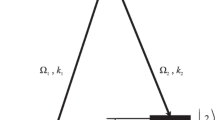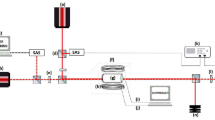Abstract
The features of electromagnetically induced transparency (EIT) in gas cells with antirelaxation coating of the walls are considered. It is shown that the simultaneous effect of the motion of atoms, the finite size of a cell, and the nondegeneracy of the ground state of atoms leads to a number of qualitative phenomena. In particular, even for the simplest three-level lambda scheme with a nondegenerate ground state, a significant difference in the spectra of EIT is revealed and investigated in detail depending on the relation between the frequencies of the probe and control fields, i.e., depending on whether the probe radiation is scattered in the Stokes or anti-Stokes channel. A significant spatial inhomogeneity of the excited low-frequency coherence is observed, which persists for large cells even far from their boundaries. In this case, the EIT resonances formed by atoms in different regions of a cell turn out to be differently shifted in frequency, which causes an additional inhomogeneous broadening of the observed profile. The observed effects are studied as a function of the nature of the accommodation of atoms on the surface of the antirelaxation coating.







Similar content being viewed by others
REFERENCES
J. P. Marangos, J. Mod. Opt. 45, 471 (1998).
M. D. Lukin, Rev. Mod. Phys. 75, 457 (2003).
M. Fleischhauer, A. Imamoglu, and J. P. Marangos, Rev. Mod. Phys. 77, 633 (2005).
I. Novikova, R. L. Walsworth, and Y. Xiao, Laser Photon. Rev. 6, 333 (2012).
M. M. Kash, V. A. Sautenkov, A. S. Zibrov, L. Hollberg, G. R. Welch, M. D. Lukin, Y. Rostovtsev, E. S. Fry, and M. O. Scully, Phys. Rev. Lett. 82, 5229 (1999).
D. Budker, D. F. Kimball, S. M. Rochester, and V. V. Yashchuk, Phys. Rev. Lett. 83, 1767 (1999).
A. V. Taichenachev, A. M. Tumaikin, and V. I. Yudin, JETP Lett. 72, 119 (2000).
A. Javan, O. Kocharovskaya, H. Lee, and M. O. Scully, Phys. Rev. A 66, 013805 (2002).
L. Ma and G. Raithel, J. Phys. Commun. 4, 095020 (2020).
D. Budker, V. Yashchuk, and M. Zolotorev, Phys. Rev. Lett. 81, 5788 (1998).
D. Budker, L. Hollberg, D. J. Kimball, J. Kitching, S. Pustelny, and V. V. Yashchuk, Phys. Rev. A 71, 012903 (2005).
M. T. Graf, D. F. Kimball, S. M. Rochester, K. Kerner, C. Wong, D. Budker, E. B. Alexandrov, M. V. Balabas, and V. V. Yashchuk, Phys. Rev. A 72, 023401 (2005).
D. Budker and M. Romalis, Nat. Phys. 3, 227 (2007).
E. B. Aleksandrov and A. K. Vershovskii, Phys. Usp. 52, 605 (2009).
M. V. Balabas, T. Karaulanov, M. P. Ledbetter, and D. Budker, Phys. Rev. Lett. 105, 070801 (2010).
M. V. Balabas, K. Jensen, W. Wasilewski, H. Krauter, L. S. Madsen, J. H. Muller, T. Fernholz, and E. S. Polzik, Opt. Express 18, 5825 (2010).
E. Breschi, G. Kazakov, C. Schori, G. di Domenico, G. Mileti, A. Litvinov, and B. Matisov, Phys. Rev. A 82, 063810 (2010).
K. Nasyrov, S. Gozzini, A. Lucchesini, C. Marinelli, S. Gateva, S. Cartaleva, and L. Marmugi, Phys. Rev. A 92, 043803 (2015).
M. A. Hafiz, V. Maurice, R. Chutanil, N. Passilly, C. Gorecki, S. Guerande, E. de Clercq, and R. Boudot, J. Appl. Phys. 117, 184901 (2015).
H. Chi, W. Quan, J. Zhang, L. Zhao, and J. Fang, Appl. Surf. Sci. 501, 143897 (2020).
S. J. Seltzera and M. V. Romalis, J. Appl. Phys. 106, 114905 (2009).
K. A. Barantsev, S. V. Bozhokin, A. S. Kuraptsev, A. N. Litvinov, and I. M. Sokolov, J. Opt. Soc. Am. B 38, 1613 (2021).
A. Krasteva, R. K. Nasyrov, N. Petrov, S. Gateva, S. Cartaleva, and K. A. Nasyrov, Optoelectron. Instrum. Proc. 54, 307 (2018).
W. Li, M. Balabas, X. Peng, S. Pustelny, A. Wickenbrock, H. Guo, and D. Budker, J. Appl. Phys. 121, 063104 (2017).
G. Kazakov, B. Matisov, A. Litvinov, and I. Mazets, J. Phys. B 40, 3851 (2007).
G. A. Kazakov, A. N. Litvinov, B. G. Matisov, V. I. Romanenko, L. P. Yatsenko, and A. V. Romanenko, J. Phys. B 44, 235401 (2011).
M. Klein, M. Hohensee, D. F. Phillips, and R. L. Walsworth, Phys. Rev. A 83, 013826 (2011).
A. Litvinov, G. Kazakov, B. Matisov, and I. Mazets, J. Phys. B 41, 125401 (2008).
S. Knappe and H. G. Robinson, New J. Phys. 12 (6), 1 (2010).
E. N. Pestov, A. N. Besedina, D. E. Pestov, and V. V. Semenov, Appl. Magn. Res. 51, 195 (2020).
S. J. Seltzer and M. V. Romalis, J. Appl. Phys. 106, 114905 (2009).
S. N. Atutov, A. I. Plekhanov, V. A. Sorokin, S. N. Bagayev, M. N. Skvortsov, and A. V. Taichenachev, Eur. Phys. J. D 72, 155 (2018).
S. N. Atutov, V. A. Sorokin, S. N. Bagayev, M. N. Skvortsov, and A. V. Taichenachev, Eur. Phys. J. D 73, 11 (2019).
M. Bhattarai, V. Bharti, V. Natarajan, A. Sargsyan, and D. Sarkisyan, Phys. Lett. A 383, 91 (2019).
S. Kobtsev, D. Radnatarov, S. Khripunov, I. Popkov, V. Andryushkov, and T. Steshchenko, J. Opt. Soc. Am. B 36, 2700 (2019).
A. Krasteva, E. Mariotti, Y. Dancheva, C. Marinelli, L. Marmugi, L. Stiaccini, S. Gozzini, S. Gateva, and S. Cartaleva, J. Contemp. Phys. 55, 383 (2020).
H. Chi, W. Quan, J. Zhang, L. Zhao, and J. Fang, Appl. Surf. Sci 501, 143897 (2020).
M. Bhattarai, V. Bharti, and V. Natarajan, Sci. Rep. 8, 7525 (2018).
S. Kobtsev, D. Radnatarov, S. Khripunov, I. Popkov, V. Andryushkov, and T. Steschenko, Proc. SPIE 10548, 1054820 (2018).
Y. Ji, J. Shang, Q. Gan, and L. Wu, in Proceedings of Electronic Components and Technology Conference (2017), Art. No. 7999974, p. 2116.
N. Sekiguchi and A. Hatakeyama, Appl. Phys. B 122, 81 (2016).
O. Yu. Tretiak, J. W. Blanchard, D. Budker, P. K. Olshin, S. N. Smirnov, and M. V. Balabas, J. Chem. Phys. 144, 094707 (2016).
M. Pellaton, C. Affolderbach, G. Mileti, R. Straessle, Y. Pétremand, D. Briand, and N. F. de Rooij, in Proceedings of the European Frequency and Time Forum 2014 (2015), Art. No. 7331561, p. 554.
G. Zhang, L. Wei, M. Wang, and K. Zhao, J. Appl. Phys. 117, 043106 (2015).
R. Straessle, M. Pellaton, C. Affolderbach, Y. Pétremand, D. Briand, G. Mileti, and N. F. de Rooij, Appl. Phys. Lett. 105, 043502 (2014).
Z. Chowdhuri, M. Fertl, M. Horras, K. Kirch, J. Krempel, B. Lauss, A. Mtchedlishvili, D. Rebreyend, S. Roccia, P. Schmidt-Wellenburg, and G. Zsigmond, Appl. Phys. B 115, 257 (2014).
R. Straessle, M. Pellaton, C. Affolderbach, Y. Pétremand, D. Briand, G. Mileti, and N. F. de Rooij, J. Appl. Phys. 113, 064501 (2013).
T. Bandi, C. Affolderbach, and G. Mileti, J. Appl. Phys. 111, 124906 (2012).
M. Hasegawa, P. Dziuban, L. Nieradko, A. Douahi, C. Gorecki, and V. Giordano, in Proceedings of the IEEE/LEOS International Conference on Optical MEMS and Nanophotonics OPTMEMS (2008), Art. No. 4607879, p. 162.
S. N. Nikolic, A. J. Krmpot, N. M. Lučic, B. V. Zlatkovic, M. Radonjic, and B. M. Jelenkovic, Phys. Scr. T 157, 014019 (2013).
I. M. Sokolov, D. V. Kupriyanov, and M. D. Havey, J. Exp. Theor. Phys. 112, 246 (2011).
N. A. Vasil’ev and A. S. Troshin, Sov. Phys. JETP 98, 1116 (2004).
A. S. Kuraptsev and I. M. Sokolov, Phys. Rev. A 91, 053822 (2015).
V. V. Batygin and I. M. Sokolov, Phys. Lett. A 108, 29 (1985).
V. I. Yudin, A. V. Taichenachev, M. Yu. Basalaev, O. N. Prudnikov, and S. N. Bagaev, J. Opt. Soc. Am. B 39, 1979 (2022).
Ya. A. Fofanov, Proc. SPIE 7993, 79930O-6 (2010).
Ya. A. Fofanov, in Advances in Optoelectronics Research, Ed. by M. R. Oswald (Nova Sci., USA, 2014), p. 75.
Ya. Fofanov, Eur. Phys. J. WEB of Conf. 220, 01004 (2019).
A. V. Belinsky and M. Kh. Shulman, Phys. Usp. 57, 1022 (2014).
Funding
This research was supported by the BASIS Foundation for the Development of Theoretical Physics and Mathematics. The influence of the nature of the accommodation of atoms on the surface of the coating on the EIT spectra was analyzed as part of the State assignment for fundamental research (no. FSEG-2020-0024). The results of the work were obtained with the use of the computational facilities of the Supercomputer Center of Peter the Great St. Petersburg Polytechnic University (http://www.spbstu.ru).
Author information
Authors and Affiliations
Corresponding author
Additional information
Translated by I. Nikitin
APPENDIX A
APPENDIX A
Neglecting the collisions of atoms with each other, we can write the system of equations for the slow amplitudes of the density matrix in the Wigner representation ρ(v, r, t) in the rotating wave approximation as
Here we assume that the control field induces transitions only from sublevel |1〉, and the probe field, only from sublevel |2〉. We also use the following notations: Vc = d31 ⋅ Ec/2\(\hbar \); Vp = d32 ⋅ Ep/2\(\hbar \); deg are the dipole moments of the transitions; Ec and Ep are the slow amplitudes of the control and probe fields, respectively; γ3 = γ31 + γ32; q = kc – kp; Δc = ωc – ω31; and Δp = ωp – ω32. For brevity we omit the arguments of the density matrix. In system (A.1), we also neglected the probabilities of spontaneous transitions between closely spaced levels |1〉 and |2〉.
Rights and permissions
About this article
Cite this article
Fofanov, Y.A., Sokolov, I.M. Electromagnetically Induced Transparency in Gas Cells with Antirelaxation Coating. J. Exp. Theor. Phys. 135, 255–263 (2022). https://doi.org/10.1134/S106377612209014X
Received:
Revised:
Accepted:
Published:
Issue Date:
DOI: https://doi.org/10.1134/S106377612209014X




